Beef tenderloin is worshipped because it is the most tender muscle on the steer. And, as such, it is usually the most expensive. Here’s what to do with a whole beef tenderloin.
The beef tenderloin is the muscle group that gives us filet mignon, tenderloin tips, and Chateaubriand. After it is trimmed and carved there can be 2 pounds or more of great spiedies/kebabs, stroganoff, boeuf bourguignon, stir fry, stew, or grinding for burgers.
Makes:
Takes:
Ingredients
- 1 beef tenderloin, unpeeled (approximately 6-7 pounds)
- 3 teaspoon Morton Coarse Kosher Salt (approximately 1/2 teaspoons per pound of meat)
- 4 tablespoons Ms. O'Leary's Cow Crust
These recipes were created in US Customary measurements and the conversion to metric is being done by calculations. They should be accurate, but it is possible there could be an error. If you find one, please let us know in the comments at the bottom of the page
Method
- Shopping. Here is an image of the whole beef tenderloin, code #1189 in the NAMP Meat Buyer's Guide. It is varies in size, but an average is about 2 1/2 feet (76.2 cm) long, 4" (10 cm) in diameter in the center, weighs 6 to 7 pounds (2.7 to 3.2kg), and can feed 12 to 16 people depending on how it is trimmed. This is the most economical way to buy this expensive cut of meat.

- It is bulbous on one end, called the "head" or the "nose", and tapered on the other, the "tail". In between is a nearly perfect cylinder 3 to 4" (7.6 to 10 cm) in diameter. It is typically sold in a plastic vacuum bag "unpeeled," meaning it still has silverskin, fat, and a long skinny secondary muscle called the "chain". The silverskin is tough connective tissue and needs to be removed. The fat should also be removed. It does not moisturize the meat when cooked.
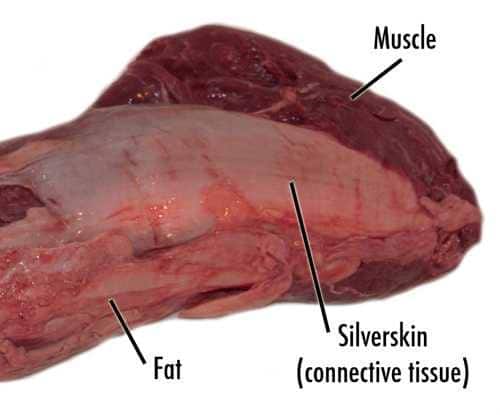
- Trim. The fat is really easy to remove. To remove the sliverskin, slip a sharp pointy knife between the silverskin and the muscle and slide it along with the blade angled upward slightly along the underside of the silverskin. Don't try to peel it with your hands or a paper towel. The meat is so tender you will damage it. When you are done, you have what is called a "Tenderloin PSMO" (Peeled, Side Muscle On), pronounced "pismo".
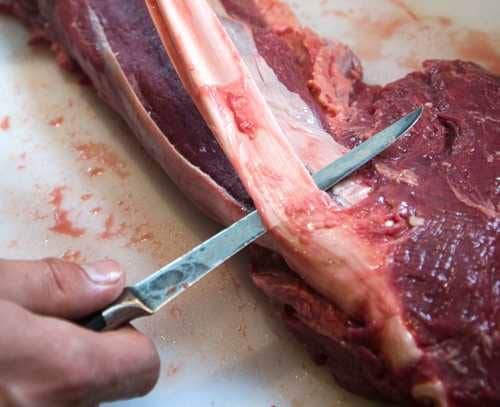
- Break it down. The large central muscle is the Psoas major. The long thin side muscle, the chain, is the Psoas minor. The football shaped muscle attached to nose end making it bulbous is the Iliacus.
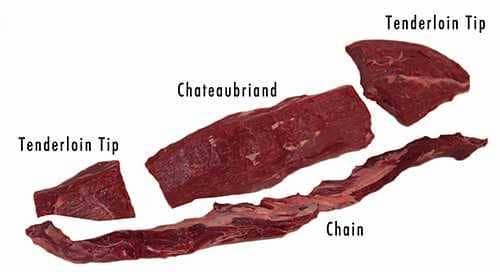
- Check out this video to learn the proper way to cut beef tenderloin for steaks and chateaubriand.
- Many chefs fold the ends in and then tie them in place so you have a long tube of fairly even thickness for roasting, but I am not fond of this procedure because the exterior of the meat can be contaminated in the slaughterhouse. That is not a problem if it is browned during cooking, but if it is folded in on itself, it will not get hot enough to be pasteurized. The risk is low, but it is a risk, and I love my family so I reduce risk whenever possible. So I prefer to lop off the thin tapered tip. When a restaurant does this, you will often see "tenderloin tips" on the menu. I set the tapered tip and the chain aside and either grind it for burgers or sausage, chop it for spiedies, or slice it for stir fry.
- The whole center section is called the chateaubriand. More often, the chateaubriand is cut into filet mignon steaks about 1 1/2 to 2" (38 to 51 mm) thick, making 6 to 8 ounce (170 to 227 g) steaks. If you leave the nose on you might be able to get 2 or 3 steaks, each 10 ounces (280g). Here's the breakdown of a typical beef tenderloin:* Raw weight 7 pounds (3.2 kg)* Chateaubriand or filets mignon 3 pounds (1.3 kg)* Stir fry from chain and tip 2 pounds (907 g)* Fat trimmed off 1 1/4 pound (567 g)* Steak from nose 3/4 pounds (340 g)
- Making chateaubriand. Here is an image of the chateaubriand. Dry brine it overnight by sprinkling it with salt and let it sit uncovered on a rack in the fridge. The salt will work its way in and help the meat hold moisture and amplify the flavors. Then give it a nice coat of Mrs. O'Leary's Cow Crust before cooking. The cooking method is virtually the same as the method I describe in my article on cooking a prime rib roast, reverse sear. Warm it gently over indirect convection heat at about 225°F (107°C) for about 30 to 40 minutes until it hits about 120°F (49°C) in the center, depending on the thickness. Then lift the lid and roll it over direct infrared radiant heat and sear the surface for about 5 minutes, roll it a bit, sear, roll, sear, roll, sear, and when all sides have formed a nice dark crust, and the interior is 125 to 130°F (52 to 54°C), perfect medium rare, pull it off, slice, and serve. Here is how to cook a chateaubriand once you have it trimmed.
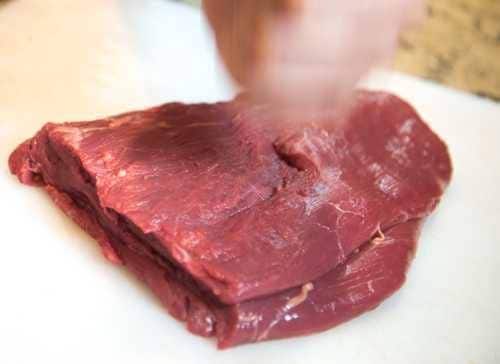
- Pound the nose. Many chefs grill the nose and sell it as tenderloin tip or just plain tenderloin, but it is a funny shape and can cook unevenly. I like to lop off the nose end and pound it into a flat steak about 1 inch thick weighing about 12 to 20 ounces (340 to 566 g). A flat filet mignon is a bit unusual, but the large surface area for browning makes it a tender treat. I cut it into 1/4" (6.3 mm) thick strips across the grain, like a flank steak. I am the only one I know who does this, but if you try it you will be a convert.
- In this video Jabin Postal demonstrate how to prepare a beef tenderloin and cook it using the reverse sear method.
- Making filets mignon. If you prefer, you can cut the chateaubriand into individual steaks about 1 to 1 1/2" (25 to 38 mm) thick called filet mignon. Above is a classic filet mignon in a cream and cognac sauce crowned with smoked cauliflower puree. Because filet mignon is thick it really should be reverse seared, not seared first. I describe the method in my article on Steakhouse Steaks.
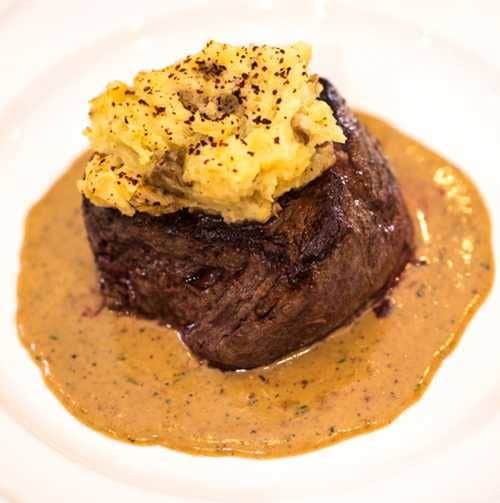
- The chain gets cut into bite size chunks for stew, stroganoff, boeuf bourguignon, stir fry, or larger chunks for spiedies/kebabs (below). It can also be ground for burgers (but you need to add some of the fat you trimmed off, it is too lean for a good burger).
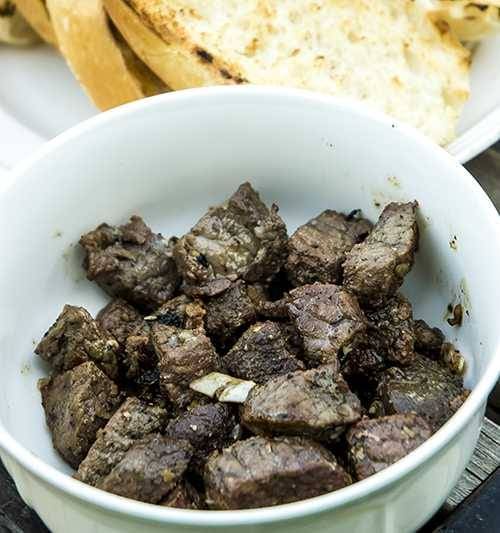

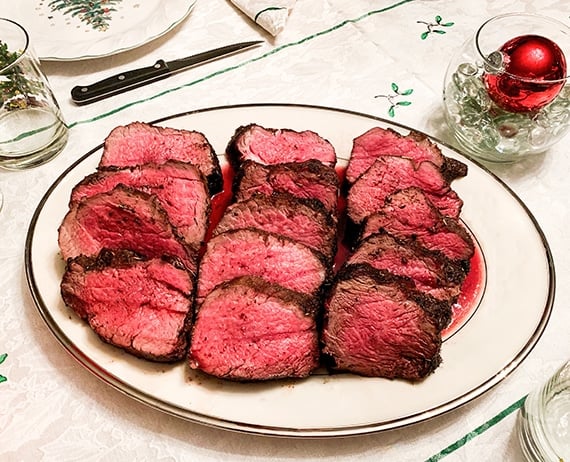

High quality websites are expensive to run. If you help us, we’ll pay you back bigtime with an ad-free experience and a lot of freebies!
Millions come to AmazingRibs.com every month for high quality tested recipes, tips on technique, science, mythbusting, product reviews, and inspiration. But it is expensive to run a website with more than 2,000 pages and we don’t have a big corporate partner to subsidize us.
Our most important source of sustenance is people who join our Pitmaster Club. But please don’t think of it as a donation. Members get MANY great benefits. We block all third-party ads, we give members free ebooks, magazines, interviews, webinars, more recipes, a monthly sweepstakes with prizes worth up to $2,000, discounts on products, and best of all a community of like-minded cooks free of flame wars. Click below to see all the benefits, take a free 30 day trial, and help keep this site alive.
Post comments and questions below
1) Please try the search box at the top of every page before you ask for help.
2) Try to post your question to the appropriate page.
3) Tell us everything we need to know to help such as the type of cooker and thermometer. Dial thermometers are often off by as much as 50°F so if you are not using a good digital thermometer we probably can’t help you with time and temp questions. Please read this article about thermometers.
4) If you are a member of the Pitmaster Club, your comments login is probably different.
5) Posts with links in them may not appear immediately.
Moderators